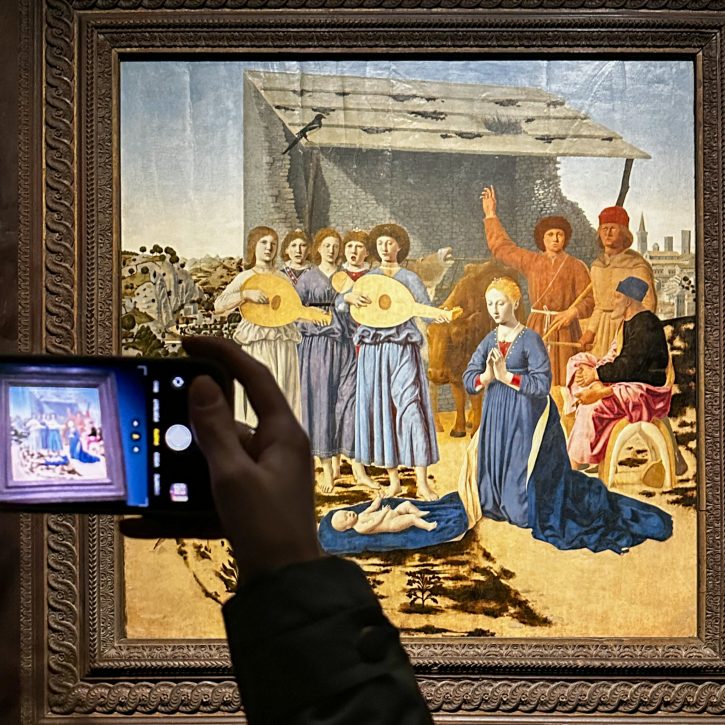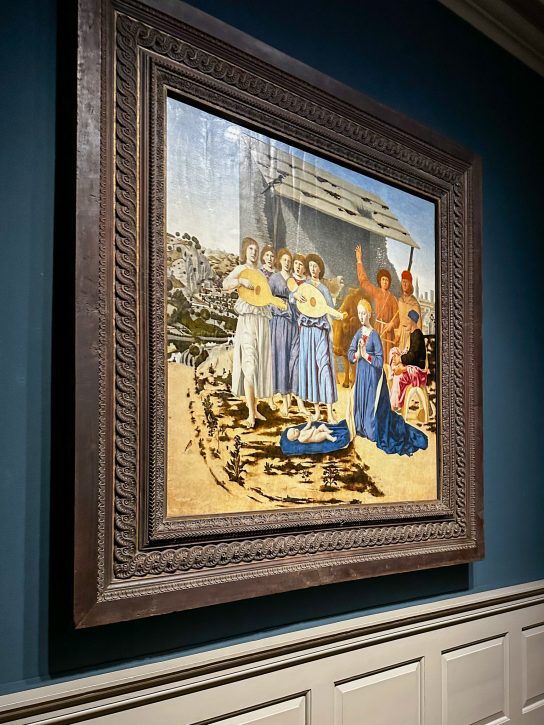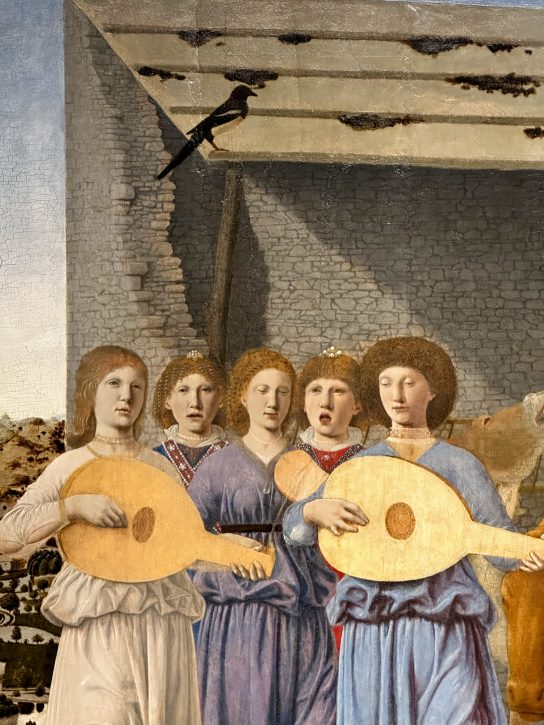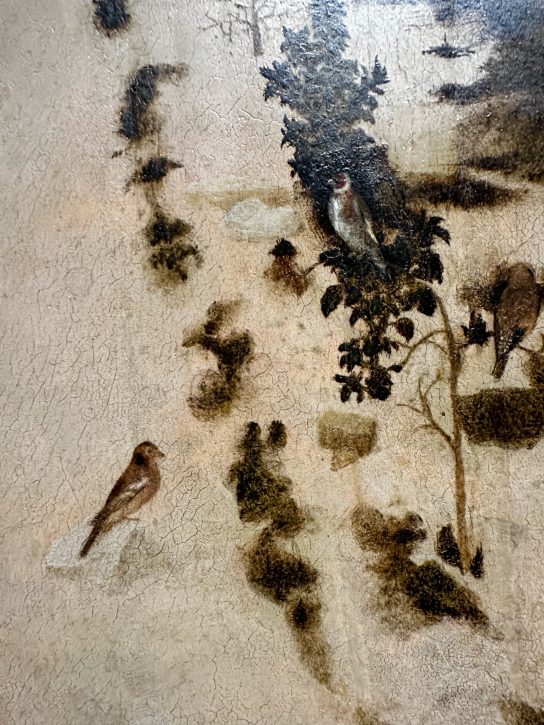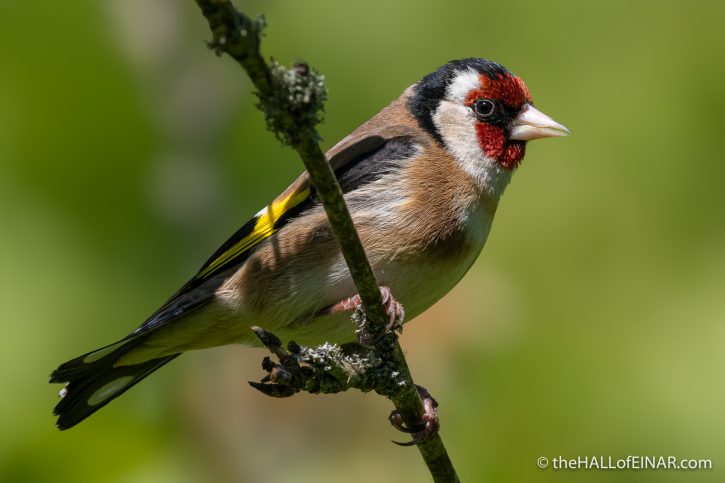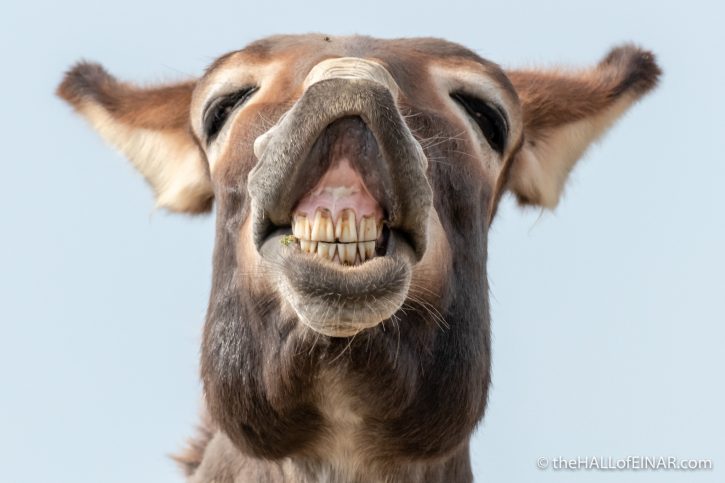Nativity
While in London, the Puffin Whisperer and I took the opportunity to visit the National Gallery to see Piero della Francesca’s painting of the Nativity. It’s been newly restored, after three years of painstaking work, and has a room to itself in the gallery.
Sadly, we didn’t have the painting to ourselves. We were as crowded as a heavenly choir of angels in there.
It’s a glorious 15th Century painting based upon a 13th Century text.
The artist, Piero della Francesca, lived from about 1415/20 to 1492. He was a rich man who wrote books on geometry and perspective and painted this Nativity for the wall of the main bedroom in his family palace. He seems like a man who didn’t need to write books or to paint to make a living. He painted this scene for himself, which must mean it had great personal significance for him.
Here’s what the National Gallery says:
Piero della Francesca (about 1415/20-1492) was among the most innovative painters of fifteenth-century Italy. A keen mathematician, he considered painting ‘a real science’ and wrote treatises on geometry and perspective. His paintings are characterised by a cool colour palette and a profound sense of space and luminosity.
I’m sad we don’t use the word treatise more. I think more people should write treatises. I feel like I’m writing one at the moment.
Piero’s works on mathematics aren’t remembered as fondly as his paintings. Some of his mathematical exercises were copied by Luca Pacioli, the father of accounting, who was the first to write a book describing modern accounting, with debits and credits in the double-entry accounting system. It seems Luca was also the first to plagiarise a mathematical text.
Since Piero’s time, people have become better at mathematics than he was, but it’s harder to be better at painting than a true master. Piero was a true master.
Piero depicted Christ’s Nativity as a miraculous vision materialising on a hill near his hometown in rural Tuscany.
Where else would he have set it? Of course it’s set in beautiful rural Tuscany.
Based on a famous account by the visionary Saint Bridget of Sweden (about 1303-1373), the Virgin kneels before the infant Christ, accompanied by Joseph and two shepherds. Five music-making angels provide a heavenly accompaniment to this otherwise rustic scene.
Saint Bridget of Sweden? Excellent. She’s the woman who was married at 13, had eight children, whose husband died, and who then dedicated herself to service, while getting into debt and constant scrapes with the authorities in Rome. It’s not entirely Saint Bridget of Sweden’s fault, but she’s the one who popularised the image of the nativity with its full cast of characters, onlookers and ne’er do-wells. I think she bears ultimate responsibility for the popularity of placing the donkey and the ox by the infant Jesus. There’s no donkey in the Bible, but there’s now a donkey in every Nativity play in infant schools. I feel sorry for the child who has to play the donkey, although it’s normally worse for the audience, especially if they sing the awful dirge, Little Donkey. Do you prefer the version by Gracie Fields, Vera Lynn or Nina & Frederik? No, I don’t like any of them either. In the interests of research, I’ve listened to all of them so you don’t have to. The Devil has all the best tunes.
By setting Bridget’s vision within a familiar landscape, Piero brought the extraordinary circumstances of Christ’s birth directly into his own world.
Saint Bridget of Sweden also set her vision within the familiar; she describes Mary as blonde. Of course it did, Bridget was Swedish.
Piero made the painting for his family palace in Borgo San Sepolcro where it remained until 1825, initially displayed in the principal bedchamber. While still in the family, parts of the paint surface were badly damaged by cleaning. Subsequent misunderstandings about its condition meant that for a long time the Nativity was thought by many to be unfinished. Over the last three years, the painting has undergone conservation and a careful restoration of the damaged areas.
I’m going to refer to my main bedroom as my principal bedchamber in future. Why speak in Anglo Saxon when you can use pretentious Norman French-derived words instead?
The faces of the two shepherds seem to have been destroyed and have been repainted. There’s something of the ‘Monkey Christ‘ about their new ruddy complexions and I wish they had been left to our imaginations. I’m here with the Puffin Whisperer, who spent four years as part of the team of eight people who restored the Sistine Chapel, so I’m listening intently to the opinion of the best in the business on the restoration. Actually, the expression on her face tells me all I need to know about the expressions on the shepherds’ faces.
Much of Piero’s original intention is newly legible, such as the overall sense of space and the divine light falling on the shed’s stone wall through a hole in its roof. The painting is now displayed in a walnut frame of the period to suggest its original grand domestic setting.
Ah yes, another part of Saint Bridget of Sweden’s vision was the Divine light:
“I saw the Child in her womb move; suddenly in a moment she gave birth to her own Son from whom radiated such ineffable light and splendour that the sun was not comparable to it while the divine light totally annihilated the material light of St. Joseph’s candle.”
The Revelations of St. Bridget
The restorers have chosen to lighten the wall of the stable in a patch to show some Divine light. It didn’t look like that before and it seems a little too obvious and clumsy to me. Why change a painting to aid its legibility?
The angels, though? The angels are stunning:
I assume the lack of strings on their instruments is due to the over-eager cleaning. The hands, faces and hairstyles are breathtaking. As is the braying donkey, obviously.
After his death Piero was mainly remembered for his mathematical studies. His fame revived from the nineteenth century onward, when the quiet grandeur and technical refinement of his paintings captivated viewers, including many painters such as Paul Cézanne, Vanessa Bell and Pablo Picasso, and writers like Aldous Huxley.
Piero is still inspiring people. Piero’s Nativity was the inspiration behind the song Picture Book by Simply Red from the 1985 album Picture Book. It’s a stream-of-consciousness set of lyrics, including the line, in the printed lyrics:
“Here by the side of Piero’s spirit.”
Except that he never actually sings that line in the recording.
He sings like an angel, doesn’t he? I’m glad his picture book fell open on that page and inspired the song. Mick Hucknall has great taste, and he’s a decent Manchester lad. Actually, Simply Red have all the best tunes.
Symbols which use nature in the painting include Goldfinches to the bottom left, which represent the Passion of Christ. That’s from another post-Biblical story, where Goldfinches saw the crown of thorns and came to pluck them out of Christ’s head and got blood on their feathers. Religion really is the opposite of science: start with an idea and arrange the evidence to fit, with ever more elaborately-fanciful stories.
The Goldfinches are beautifully painted, but the one on the far left looks like a Chaffinch to me. Here’s what a Goldfinch should look like:
Unless, of course, it’s a Goldfinch which has been cleaned too severely.
There’s also a Magpie perched on the stable roof. I’m still wondering what the Magpie symbolises. Any ideas?
There are pearls trimming the bodice of Mary’s dress, which symbolise purity and chastity. Saint Bridget was certain that Jesus was born by Divine light and hadn’t passed through Mary’s birth canal. After giving birth eight times I’m sure it must have been as easy as shelling peas for Bridget, but I admire her imagination about Mary’s virgin birth being by Divine light.
Here’s a summary of my reaction to the Revelations of Saint Bridget:
Piero della Francesca’s Nativity is a stunning painting and if you can stand to visit London, it’s well worth having a transcendent moment with it.
